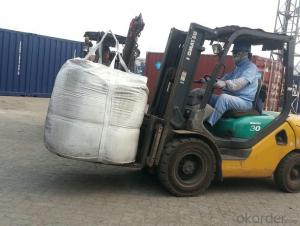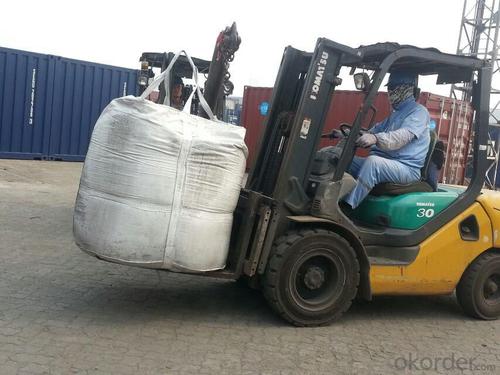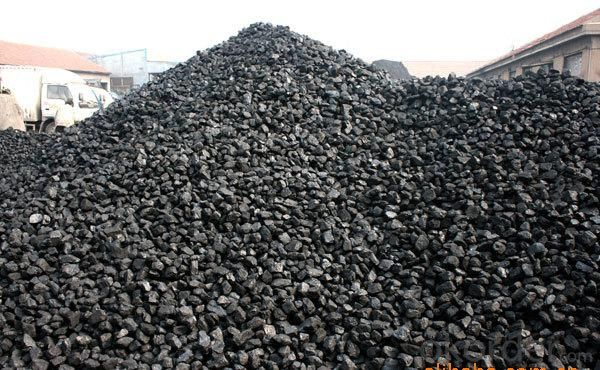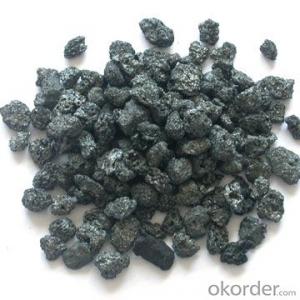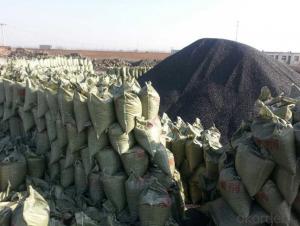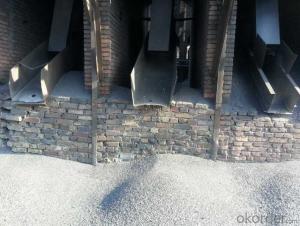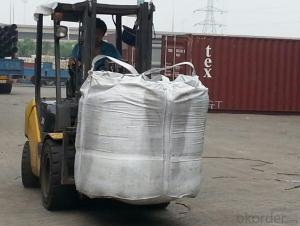Incharge Coke FC90 with Good and Stable Quality
- Loading Port:
- Tianjin
- Payment Terms:
- TT OR LC
- Min Order Qty:
- 20 m.t.
- Supply Capability:
- 5000 m.t./month
OKorder Service Pledge
OKorder Financial Service
You Might Also Like
Incharge Coke FC90 with Good and Stable Quality
Packaging & Delivery
25kgs/50kgs/1ton per bag or as buyer's request
Specifications
Incharge Coke FC90 with Good and Stable Quality
Calcined Anthracite
Fixed carbon: 90%-95%
S: 0.5% max
Size: 0-3. 3-5.3-15 or as request
Incharge Coke FC90 with Good and Stable Quality
It used the high quality anthracite as raw materials through high temperature calcined at over 2000 by the DC electric calciner with results in eliminating the moisture and volatile matter from anthracite efficiently, improving the density and the electric conductivity and strengthening the mechanical strength and anti-oxidation. It has good characteristics with low ash, low resistvity, low sulphur, high carbon and high density. It is the best material for high quality carbon products.
Advantage and competitive of caclined anthracite:
Incharge Coke FC90 with Good and Stable Quality
1. strong supply capability
2. fast transportation
3. lower and reasonable price for your reference
4.low sulphur, low ash
5.fixed carbon:95% -90%
6..sulphur:lower than 0.3%
General Specification of Calcined Anthracite:
Incharge Coke FC90 with Good and Stable Quality
| FC | 95 | 94 | 93 | 92 | 90 |
| ASH | 4 | 5 | 6 | 6.5 | 8.5 |
| V.M. | 1 | 1 | 1 | 1.5 | 1.5 |
| S | 0.3 | 0.3 | 0.3 | 0.35 | 0.35 |
| MOISTURE | 0.5 | 0.5 | 0.5 | 0.5 | 0.5 |
Pictures
Incharge Coke FC90 with Good and Stable Quality
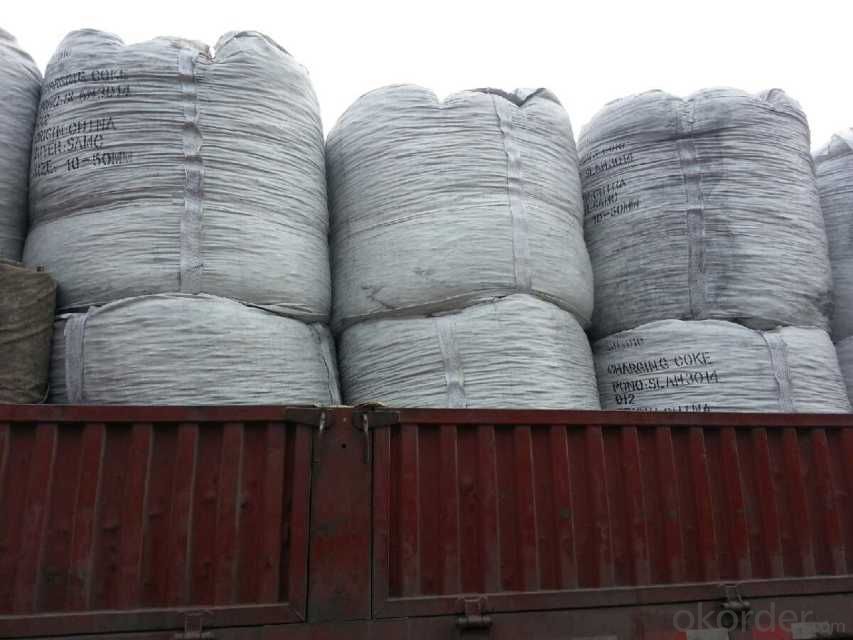
FAQ:
Incharge Coke FC90 with Good and Stable Quality
Why we adopt carbon additive?
Carbon Additives used as additive in steel making process. It made from well-selected Tai Xi anthracite which is low in content of ash, sulphur, phosphorus, high heat productivity, high chemically activation.
Mainly industry property of it is: instead of traditional pertroleum coal of Carbon Additives, reduce the cost of steelmaking.
- Q: How does carbon form?speed
- How is coal formed?Coal is known as black gold, the food industry, it is one of the main energy use of the human world since eighteenth Century. Although its important position has been replaced by oil, but in the future for a long period of time, due to the exhaustion of petroleum, inevitable decline, but because of the huge reserves of coal, and the rapid development of science and technology, the new technology of coal gasification is becoming more mature and widely used, coal will become one of the production and life of human beings in an irreplaceable energy.Coal is millions of years of plant leaves and roots, stacked on the ground with a layer of very thick black humus, due to changes in the earth's crust constantly buried underground, long isolated from the air and under high temperature and pressure, after a series of complex physical and chemical changes and other factors, the formation of black however, this fossil, is the coal forming process.The thickness of coal seam in a coal mine and the crust drop speed and accumulation amount of plant remains. The crust decreased rapidly, the plant remains piled thick, the coal seam is thick, on the other hand, the crust decline slowly, the accumulation of plant remains thin, the mine coal seam is thin. The tectonic movement of the crust to the original level of coal seam folds and faults occur, some underground coal seam buried deeper, and squeezed to the surface, even above the ground, more likely to be found. There are some relatively thin coal seam, and the area is not large, so there is no value related to the formation of coal mining, so far not find the update statement.
- Q: What are the impacts of carbon emissions on the stability of rainforests?
- Carbon emissions have significant impacts on the stability of rainforests. Increased levels of carbon dioxide in the atmosphere due to emissions contribute to global warming, leading to changes in rainfall patterns and increased temperatures. These changes can negatively affect the delicate balance of rainforest ecosystems, causing droughts, wildfires, and loss of biodiversity. Additionally, carbon emissions contribute to the acidification of oceans, which can harm marine life that rainforests depend on, such as coral reefs. Overall, carbon emissions pose a serious threat to the stability and long-term survival of rainforests.
- Q: How does deforestation contribute to carbon dioxide levels in the atmosphere?
- Deforestation contributes to carbon dioxide levels in the atmosphere primarily through the release of stored carbon in trees and vegetation. When forests are cut down or burned, the carbon stored in their biomass is released as carbon dioxide, a greenhouse gas. Additionally, trees play a crucial role in absorbing carbon dioxide during photosynthesis, so their removal reduces the capacity to remove this greenhouse gas from the atmosphere. Therefore, deforestation not only releases carbon dioxide but also diminishes the natural carbon sinks, leading to an overall increase in carbon dioxide levels in the atmosphere.
- Q: What is carbon PC?
- Polycarbonate (PC), polycarbonate is a molecular chain containing [O-R-O-CO] chain thermoplastic resin according to the molecular structure of the ester can be divided into aliphatic, alicyclic and aromatic type of fat, which has the practical value of the aromatic polycarbonate, and bisphenol A polycarbonate as the most important, molecular weight is usually 3-10 million.Polycarbonate, English Polycarbonate, referred to as PC.PC is a kind of amorphous, odorless, non-toxic, highly transparent colorless or slightly yellow thermoplastic engineering plastics, has excellent physical and mechanical properties, especially excellent shock resistance, tensile strength, bending strength, compressive strength and high creep; small size is stable; good heat resistance and low temperature resistance, mechanical properties, stability in a wide range of temperature dimensional stability, electrical properties and flame retardant properties, can be used for a long time at -60~120 deg.c; no obvious melting point, a molten state at 220-230 DEG C; the molecular chain rigidity, melt viscosity and high water absorption resin; small, small shrinkage, high precision, good dimensional stability, permeability of films is small; self extinguishing materials; stable to light, but not UV resistance, good weather resistance; oil resistance, acid and alkali resistance, no oxygen acid and amine, Ketones are soluble in chlorinated hydrocarbons and aromatic solvents. They are easy to cause hydrolysis and cracking in water for a long time. Because of their poor fatigue resistance, they are prone to stress cracking, poor solvent resistance and poor wear resistance
- Q: How are carbon nanotubes used in various applications?
- Carbon nanotubes possess remarkable versatility and have discovered countless applications across diverse fields. In the realm of electronics, they serve as an alternative to conventional silicon-based materials, thereby facilitating the creation of smaller, faster, and more efficient devices. They function as the fundamental components for transistors, interconnects, and memory devices. Within the energy sector, researchers are exploring the potential of carbon nanotubes to enhance battery and supercapacitor performance. Their exceptional electrical conductivity and expansive surface area render them ideal for augmenting energy storage and expediting charge and discharge rates. Moreover, carbon nanotubes find utility in the realm of materials science. By incorporating them into composites, it is possible to bolster their strength, rigidity, and electrical conductivity. These composites prove valuable in the aerospace, automotive, and construction industries, where lightweight and durable materials are in high demand. Furthermore, carbon nanotubes are under investigation for their medical applications. Thanks to their distinct properties, they can be utilized in drug delivery systems, sensors, and imaging technologies. They possess the ability to selectively target cancer cells, thereby enabling more efficient and precise treatment alternatives. To summarize, carbon nanotubes offer an extensive array of applications, ranging from electronics and energy storage to materials science and medicine. Their exceptional properties make them highly coveted for enhancing performance and driving advancements across various industries.
- Q: How is carbon used in the production of pigments?
- Carbon is commonly used in the production of pigments due to its ability to create vibrant and deep colors. Carbon-based pigments, also known as carbon blacks, are produced by the incomplete combustion of hydrocarbons, such as natural gas or petroleum. The carbon particles produced during this process are then processed and purified to create a fine powder that can be used as a pigment. These carbon-based pigments have a wide range of applications in various industries, including inks, paints, plastics, and cosmetics. In the production of inks, carbon black is often added to improve the color intensity and opacity of the ink. It is also used in the manufacturing of black pigments for paints and coatings, providing a rich and deep black color. Carbon-based pigments are also used in the production of plastics. Adding carbon black to plastic materials can enhance their UV resistance, making them more durable and long-lasting. This is particularly important in outdoor applications where exposure to sunlight can cause fading and degradation. Additionally, carbon-based pigments are commonly used in the cosmetics industry. They are added to various cosmetic products, such as eyeliners, mascaras, and lipsticks, to create intense black or dark shades. Carbon black pigments are preferred in cosmetics due to their stability and ability to deliver consistent color. In conclusion, carbon is widely used in the production of pigments due to its ability to create vibrant and deep colors. Carbon-based pigments find applications in various industries, including inks, paints, plastics, and cosmetics, where they enhance color intensity, provide UV resistance, and deliver rich black shades.
- Q: How does carbon affect the melting of polar ice caps?
- Carbon affects the melting of polar ice caps by contributing to global warming. As carbon dioxide levels increase in the atmosphere, it acts as a greenhouse gas, trapping heat and causing the Earth's temperature to rise. This leads to the melting of polar ice caps, as the increased temperatures accelerate the melting process, causing the ice to melt at a faster rate.
- Q: What is carbon nanophotonics?
- The study and manipulation of light at the nanoscale using carbon-based materials is known as carbon nanophotonics. This branch of science and technology integrates carbon nanotubes, graphene, and diamond nanoparticles with photonics to develop new optical devices and systems. Carbon-based nanomaterials possess exceptional electrical conductivity, high mechanical strength, and excellent optical properties, making them ideal for nanophotonics applications. These materials can confine and manipulate light at the nanoscale, enabling the miniaturization of optical components and enhancing light-matter interactions. Carbon nanophotonics has vast potential across various fields. Telecommunications, for instance, can benefit from high-speed and compact photonic devices developed using carbon nanomaterials for efficient data transmission. In the field of sensing, highly sensitive and selective sensors can be developed using carbon nanophotonics to detect different molecules and substances. Furthermore, carbon nanomaterials can enhance the efficiency of solar cells and other photovoltaic devices, contributing to advancements in energy harvesting. In summary, carbon nanophotonics is a rapidly evolving field that combines carbon-based nanomaterials with photonics to create innovative optical technologies. By harnessing the power of light at the nanoscale, this field has the potential to revolutionize industries and drive advancements in science and technology.
- Q: What should I do when carbon monoxide leaks?
- Of course, in saving at the same time, to find out the cause of the gas leak as soon as possible, and to other people and then plugging, lest suffer. PoisoningTo avoid leakage and gas poisoning accident occurred in the home, can install household gas alarm detector | gas leak alarm, it can predict in advance the gas leak alarm, prompting the user, open the window as soon as possible to prevent accidents.
- Q: How is carbon used in the production of paints?
- Paint production utilizes carbon in multiple ways. An important application of carbon in paint production involves its use as a pigment. Carbon black, a type of elemental carbon, is commonly employed as a black pigment in various paint types. It imparts a deep and intense black hue, along with exceptional light absorption characteristics, making it ideal for creating dark tones in paints. Additionally, carbon plays a role in the formulation of specific paint types, such as carbon-based coatings. These coatings find application in scenarios demanding resistance against heat, chemicals, and corrosion. Industries like automotive, aerospace, and marine frequently employ carbon-based coatings, where durability and protection are paramount. These coatings can be applied to diverse surfaces, providing a high level of protection and extending the lifespan of the painted object. Furthermore, carbon serves as a filler material in certain paint varieties. Carbon fillers are added to enhance the mechanical properties of the paint, including strength, hardness, and resistance to wear and tear. They also contribute to the overall performance of the paint, augmenting its durability and longevity. In conclusion, carbon is an indispensable component in paint manufacturing, fulfilling roles as a pigment, a constituent of coatings, and a filler material. Its versatile properties make it a valuable addition to various paint formulations, enhancing the aesthetic appeal, durability, and performance of the final product.
Send your message to us
Incharge Coke FC90 with Good and Stable Quality
- Loading Port:
- Tianjin
- Payment Terms:
- TT OR LC
- Min Order Qty:
- 20 m.t.
- Supply Capability:
- 5000 m.t./month
OKorder Service Pledge
OKorder Financial Service
Similar products
Hot products
Hot Searches
